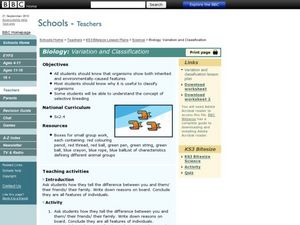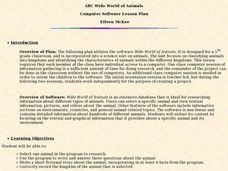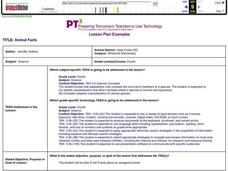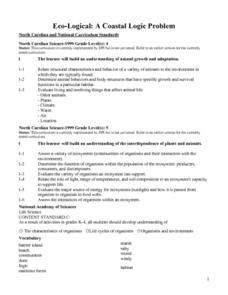Curated OER
Taxonomy Concept Map
Reinforce learners' knowledge of scientific taxonomy with a helpful concept map learning exercise. Using a word bank, young biologists fill in the blanks to complete the description of organism classification.
Curated OER
Species Charades
Students identify endangered species. In this endangered species lesson plan, the teacher leads a discussion about endangered species, then the class plays a game of charades to pantomime animal behavior.
Curated OER
A Little Horse Sense
How have horses evolved over time? How do horse skulls reveal this evolution? How have the roles horses play changed over time? What kind of social structure do horse herds have? How should wild horse populations be managed? To find the...
Curated OER
What Kind Of Mammal Is It?
Learners describe the characteristics of a mammal. They also differentiate between a companion and a wild animal. The lesson plan has an assessment included in it. They have a discussion to tap prior knowledge about what a mammal is.
Curated OER
Classification 2
Students discuss what makes a living thing (for example, cellular respiration) and collect a selection of living things from outside. They divide their organisms into plants and animals and create a key for the divisions.
Curated OER
Aim-- Use a Carroll Diagram to Sort Animals
In this science learning exercise, students cut out pictures of 12 animals and paste them into the correct space on the Carroll diagram. Students classify animals as living in water or land and with or without legs.
Curated OER
Invertebrate Classification
High schoolers discuss the recent disovery of the "furry lobster" to peak interest in the animal kingdom. They classify various speciments using invertebrate dichotomous keys, identifying major animal phyla and classes. Thy the complete...
Curated OER
Poriferans and Cnidarians
Students study the major phyla of the animal kingdom. In this biology instructional activity unit, students identify their general characteristics. They define taxonomy terminologies.
Curated OER
Biology: Variation and Classification
Students investigate classification of different animal groups. In this biology instructional activity students list characteristics of themselves and others they know to show differences and how they are classified. Students then answer...
Curated OER
Survival
Students identify characteristics of Australia, Africa and Antarctica and compare and contrast them to each other. They work together to identify adaptations that animals have used to survive. They also practice classifying animals.
Curated OER
How Are Animals Classified?
In this animal classification worksheet, students describe the animal kingdom including invertebrates, vertebrates, birds, and mammals. This worksheet is a graphic organizer.
Curated OER
Welcome to the Kingdom
Students study animal classification. In this classification lesson students examine animal characteristics and answer questions on a handout.
Curated OER
Touching Traits
Students describe objects using only their sense of touch. In this lesson on describing characteristics, students use only their sense of touch to describe an unseen object in a box. This lesson can be used an an introduction to plant...
Curated OER
Kingdom Animalia
Students are introduced to the basic characteristics of the animal kingdom. this activity is part of a multi-segmented unit on the diversity of life. In this segment, students explore the the members of a few phyla of the animal kingdom.
Curated OER
ABC Wide World of Animals
Fifth graders use the software Wide World of Animals. This lesson is incorporated into a science unit on animals. The unit focuses on classifying animals into kingdoms and identifying the characteristics of animals within the different...
Curated OER
Raising an Animal
Students observe reproduction and behavior in several types of animals and nurture a sense of responsibility and cooperation. They then examine external features of several different types of animal groups.
Curated OER
Who's Who? Integrated Core
Student discuss names and nicknames for human and animal families and complete a worksheet, matching pictures of father, baby and mother animals.
Curated OER
Invertebrate Chordates
Most chordates are easy to identify because of the specific classification criteria of their phylum. But what about tunicates? Young scientists read a short explanation about why tunicates, or sea squirts, are considered to be members of...
Curated OER
Animals
Young scholars explore biology by participating in a science vocabulary activity. In this animal species lesson, students define a list of animal vocabulary terms as well as practice using them in sentences with the appropriate...
Curated OER
Animal Facts
Fourth graders list five facts about an assigned animal, and complete a bird beak activity, using pliers, blunt pencils, forceps, clothespins, and a spoon that represent different types of beaks; students complete chart showing best type...
Curated OER
Native vs. Non-native Species: Who Will Win?
Students examine non-native species and the problems they have caused in the waters of the Chesapeake Bay. They create a "Wanted" poster for one of the species. They describe the effects of non-native species on the schoolyard species.
Curated OER
Jay Play
Students explore animal characteristics by participating in a bird observation activity. In this blue jay identification lesson, students discuss the different types of blue jays native to their environment and bait them to come close...
Curated OER
Biome Project
In this earth science worksheet, students act as travel agents for a particular biome and construct a brochure to sell the class on benefits of taking a vacation to their biome. They include each of the features given in the exercise.
Curated OER
Eco-Logical: A Coastal Logic Problem
Fourth graders study the characteristics of five coastal communities. They use logic cards and matching activities to identify the proper community for plant and animal species.
Other popular searches
- Plant Animal Classification
- Animal Classification System
- Animal Taxonomy Game
- Animal Classification Test
- Animal Classification Fish
- Animal Classification Units
- Classifying Animals Chart
- Diversity of Animal Kingdom
- Animal Classification Lesson
- Classifying Animal Groups
- 5e Animal Classification
- Science Classifying Animals

























